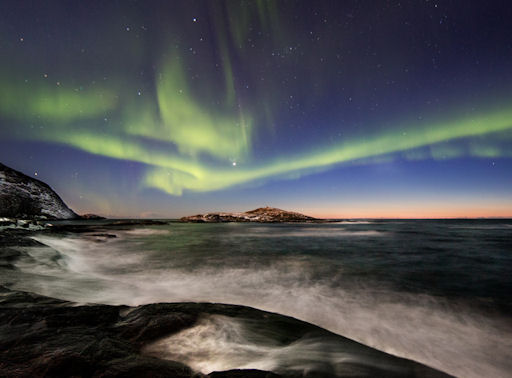AURORA WATCH: A CME expected to reach Earth on April 4th is overdue. The cloud might have missed or maybe it's running late. Mindful of a possible impact, NOAA forecasters estimate a 15% chance of polar geomagnetic storms on April 5th. Aurora alerts: text, phone.
With the arrival of Spring, Arctic nights are growing shorter. "Soon, aurora season will be coming to an end," says Norwegian photographer Thorbjørn Riise Haagensen. "But it's not over yet." Last night Haagensen photographed this scene over Hillesøy, Norway:
"Beginning in the middle of May, the midnight sun brings sunshine all night long," he says. "Already some daylight is visible at the horizon at midnight. There is still enough darkness, though, for the last dance of the auroras."
more images: from Bob Conzemius of Grand Rapids, Minnesota; from Gilles Boutin of Ivujivik Nunavik Canada; from Frank Olsen of Blokken in Sortland, Norway; from Helge Mortensen of Kvaløya, Norway; from Ole C. Salomonsen of Sommarøy, Tromsø, Norway; from Thilo Bubek of Tromsø, Norway;
HEAVENLY DEJA VU: At first glance, the picture below looks exactly like thousands of others taken this week as Venus passed through the Pleaides star cluster. Look again. The date in the corner says "April 1972." Richard Keen of Boulder, Colorado, took the picture 40 years ago:
Talk about deja vu!
"Thanks to its orbit, Venus' appearance in the sky repeats itself almost exactly every 8 years," explains Keen. "Forty years ago, on April 2, 1972, Venus passed by the Pleiades only half a degree from its position two days ago. It's fun to compare this photo I took back in 1972 with this week's wonderful images."
Venus is exiting the Pleiades now, but as Keen's snapshot shows, there will be a next time--eight years from now to be exact. The next Venus-Pleaides conjunction is due in April 2020. Until then....
more images: from Fred Espenak of Portal, Arizona; from Kamila Mazurkiewicz of Puławy, Poland; from Jimmy Westlake of Steamboat Springs, Colorado; from Efe Tuncel of Ankara, Turkey; from Fritz Helmut Hemmerich of Tenerife (Canary Islands); from Marion Haligowski of Phoenix, Arizona; from Aaron Top of Shallow Lake, Ontario; from Marek Nikodem of Szubin, Poland; from M. Raşid Tuğral of Ankara, Turkiye; from Ugur Ikizler of Mudanya - Bursa / Turkey; from Gadi Eidelheit of Givat Shmuel, Israel
![]()

![]()
Solar wind
speed: 340.8 km/sec
density: 2.1 protons/cm3
explanation | more data
Updated: Today at 1606 UT
![]()
X-ray Solar Flares
6-hr max: B9 1327 UT Apr05
24-hr: B9 1327 UT Apr05
explanation | more data
Updated: Today at: 1600 UT
![]()
![]()
![]()
Daily Sun: 04 Apr 12
![]()
![]()
Solar activity is low. None of these sunspots is actively flaring. Credit: SDO/HMI
![]()
![]()
![]()
Sunspot number: 60
What is the sunspot number?
Updated 03 Apr 2012
Spotless Days
Current Stretch: 0 days
2012 total: 0 days (0%)
2011 total: 2 days (<1%)
2010 total: 51 days (14%)
2009 total: 260 days (71%)
Since 2004: 821 days
Typical Solar Min: 486 days
Updated 03 Apr 2012
The Radio Sun
10.7 cm flux: 104 sfu
explanation | more data
Updated 03 Apr 2012
![]()
![]()
![]()
Current Auroral Oval:
![]()
Switch to: Europe, USA, New Zealand, Antarctica
Credit: NOAA/POES
![]()
![]()
![]()
Planetary K-index
Now: Kp= 3 quiet
24-hr max: Kp= 4 unsettled
explanation | more data
![]()
Interplanetary Mag. Field
Btotal: 8.1 nT
Bz: 7.7 nT north
explanation | more data
Updated: Today at 1606 UT
![]()
![]()
![]()
Coronal Holes: 04 Apr 12
![]()
![]()
A solar wind stream flowing from this southern coronal hole could brush against Earth's magnetic field on April 7th. Credit: SDO/AIA.






